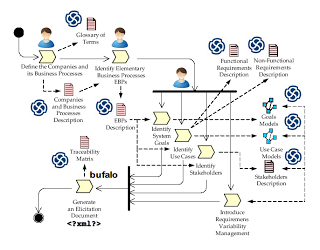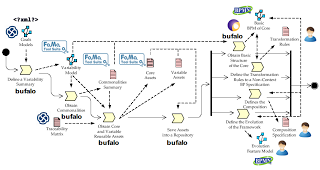Bufalo released!
Blog: BPM Research
After many months of work, I have finally completed one of the most important milestones of my doctoral thesis. Specifically, the implementation of a software tool to support the proposed Business Family Engineering methodology.
I named this tool with the name bufalo. Its aim is to cover the stages of “Business Family Domain Engineering” explained here. The following chart can be viewed as phases have been defined that are supported by the tool and which require the user to be performed.

Obviously the first phase, corresponding to Business Family Requirements Engineering takes place entirely by the user, as it is who defines the family members, their requirements, goals, etc. There are lots of tools that support these tasks, Enterprise Architect being the most commonly used alternative. That is why Bufalo is able to integrate and interact with the API of Enterprise Architect and obtain a complete definition of requirements specification document for each member of the family, independently of the template used. Besides the definitions of each business can be formatted in wiki format for project management applications such as Redmine and Trac, among others.

Once we have the definition of each business is when bufalo acts as a suitable position in the second phase, corresponding to Business Family Domain Design, orchestrating the process of extracting the business objectives of the definition, transforming these objectives a model of variability in the format you want, in the current version supports FAMA, and getting the definition of the core framework through a transformation process ATL between features and models business processes defined in BPMN.
Technically speaking, Bufalo is presented as a Maven plugin that can be launched through continuous integration systems like Hudson, which integrate into a software ecosystem is quite simple. The business definitions can be hosted on Subversion repositories and will be bufalo type who remove these definitions of the routes indicated process and get the core framework of each, as well as a definition of a Java object representing the family business identifiable by removing tags using the service in the cloud Yahoo Term Extraction. BPMN and FAMA models will be uploaded due to the Subversion user specified for each of the definitions of business.
Since the first version of the product, for now the definition of transformation rules as well as the evolution of business model are bound to be made by the user. At the end of the first quarter of next year is planned the publication of the release of the first version of this product, by now you can see how does the extraction of information from a business document defined in Enterprise Architect in the next video.
Leave a Comment
You must be logged in to post a comment.







